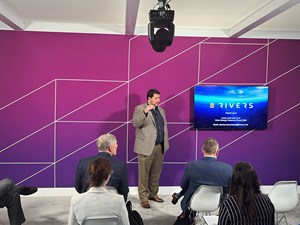Decarbonization using sour-to-sweet gas technology
At CERAWeek by S&P Global 2023, energy innovators gathered to share insights, technologies and business models across the energy spectrum. On day 2, Damian Beauchamp, President and Chief Development Officer for 8 Rivers, delivered a presentation titled “Sour Gas to Sweet Gas Technology and its Role in Decarbonization.” The presentation focused on the company’s TarT technology, a low-cost solution for processing high-hydrogen sulfide (H2S) sour gas. The technology separates H₂S and other sulfurous contaminants from sour natural gas, using CO₂ as a natural solvent.

Beauchamp began the presentation by introducing 8 Rivers to audience members unfamiliar with the company. 8 Rivers was founded 15-yr-ago in North Carolina and focuses on large industrial-scale decarbonization. The company has more than 400 patents and has raised more than $1 B across its platform, including technologies, projects and business model innovations.
The company is most well known for developing the Allam-Fetvedt Cycle, which uses oxy-combustion of carbon fuels and a high-pressure supercritical CO2 working fluid in a highly recuperated cycle that captures all emissions by design. The only by-products are liquid water and a high-purity, pipeline-ready CO2 stream. 8 Rivers also works with biomass, carbon capture, blue hydrogen (H2) and direct air capture.
According to the International Energy Agency, coal is responsible for most global CO2 emissions. With this information, Beauchamp gives the framework on how sour gas can quickly help decarbonization targets. “Across the world, 40% of the world's reserves are sour; 20% are so sour that prior to TarT, they were technically and economically irrecoverable,” said Beauchamp. “These reserves could not be processed with conventional technology.”
According to Beauchamp, 8 Rivers intended to take H2S into a supercritical CO2 oxycombuster, which proved unfeasible due to the corrosivity of H2S. “We had a lot of work to do to figure out how we can process this highly sour gas in an economical manner,” Beauchamp said. “The solution our engineering team arrived at was fairly counter-intuitive. When working to purify something, typically, you don’t take the first step of introducing a contaminant. As a first step of the process, we introduced CO2 as a scrubbing agent to reduce the H2S. This worked well because the boiling points of H2S and CO2 are similar.”
According to Beauchamp, the dilution with CO2 and taking a cryogenic approach reduces the corrosivity of the H2S throughout the process. The process begins with pretreating—removing moisture, mercury and other common contaminants. Next, they use a refrigeration unit to cool it to -90°C, creating a liquid of C1 H2S CO2 C2+.
They then removed the C1 with some CO2 and put it through a separex membrane to provide sweet gas (methane). To separate the natural gas liquids (NGLs), they used Honeywell UOP’s membrane to separate the ethane from its second cryogenic column. According to Beauchamp, in between the C2 and C3 separation, they pull out H2S at relatively high purity. “The benefit of pulling off H2S at relatively pure form is it allows you to go through a Claus unit with a reduced CAPEX of the Claus unit because you have a higher concentration of H2S,” said Beauchamp.
According to the company’s partner’s analysis (Toyota Engineering), the CAPEX investment is approximately 20% less than conventional processes, and the OPEX is reduced by approximately 50%. “The primary driver for the systems CAPEX is the diameter of the cryogenic column,” said Beauchamp. “Depending on the composition of the gas, the diameter of the columns will be adjusted, and the CAPEX will scale accordingly.”
Beauchamp went on to discuss this technologies usefulness in H2 production. According to Beauchamp, the process can convert the sour gas to methane, converting the methane to H2. Due to the cheap reserves and low processing costs, a low-cost feedstock can be provided to lower the cost of H2 production. “Because this is a cryogenic system, it can integrate well with LNG, so where you have large sour gas reserves, the cryogenic system sees benefits from the cryogenic systems of natural gas liquefaction,” Beauchamp said.
According to Beauchamp, 8 Rivers has begun experimenting with converting H2S to H2. “Because you just replace the oxygen with the sulfur, this is a feasible process,” Beauchamp said. “There are several groups around the world still in the R&D phase. 8 Rivers has done a full analysis of these processes, and we have identified two or three that are very attractive and that we will continue to pursue.”
Beauchamp ended the presentation by explaining how these processes can reduce CO2 emissions. He said the different forms of power generation from different fuel sources have different emissions profiles, with gas emissions profile being much lower than coal. Beauchamp then asked: what if we have these sour gas reserves available to us instantaneously today?
“Our estimates are that if you were to replace all the coal generation with natural gas, you would have an unabated, instantaneous reduction of 6.5-B metric t of CO2, which is over 15% of the emissions across the world,” Beauchamp said. “Additionally, because it’s a cryogenic system, in typical gas processing, the CO2 that is in a gas escapes to the atmosphere. We have captured that CO2 as a liquid and that CO2 can be mixed back with the H2S, produced as a pure strain or permanently sequestered.”
Story by: Tyler Campbell, Managing Editor, H2Tech
Related News
Related News

- ExxonMobil halts 1-Bft3d blue hydrogen project in Texas
- Aramco and Yokogawa commission multiple autonomous control AI agents at Fadhili gas plant
- Ukraine will resume gas imports via Transbalkan route in November
- Mitsubishi to inject $260 MM into Brunei LNG project
- Freeport LNG (U.S.) on track to take in more natgas on Thursday after unit outage



Comments